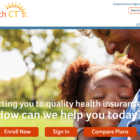Access Health CT
Access Health CT Open Enrollment Begins Nov. 1; Eligible Consumers Can Sign Up Now
|
As the state readies for open enrollment for health insurance beginning November 1, those who have lost their jobs or have recently moved to Connecticut can get coverage now through Access Health CT (AHCT). For those who don’t have a qualifying event for special enrollment—such as getting married, giving birth or adopting a child—open enrollment for 2021 health insurance plans begins Nov. 1 and runs through Dec. 15. Consumers can begin “window shopping” and comparing plans on Oct.



